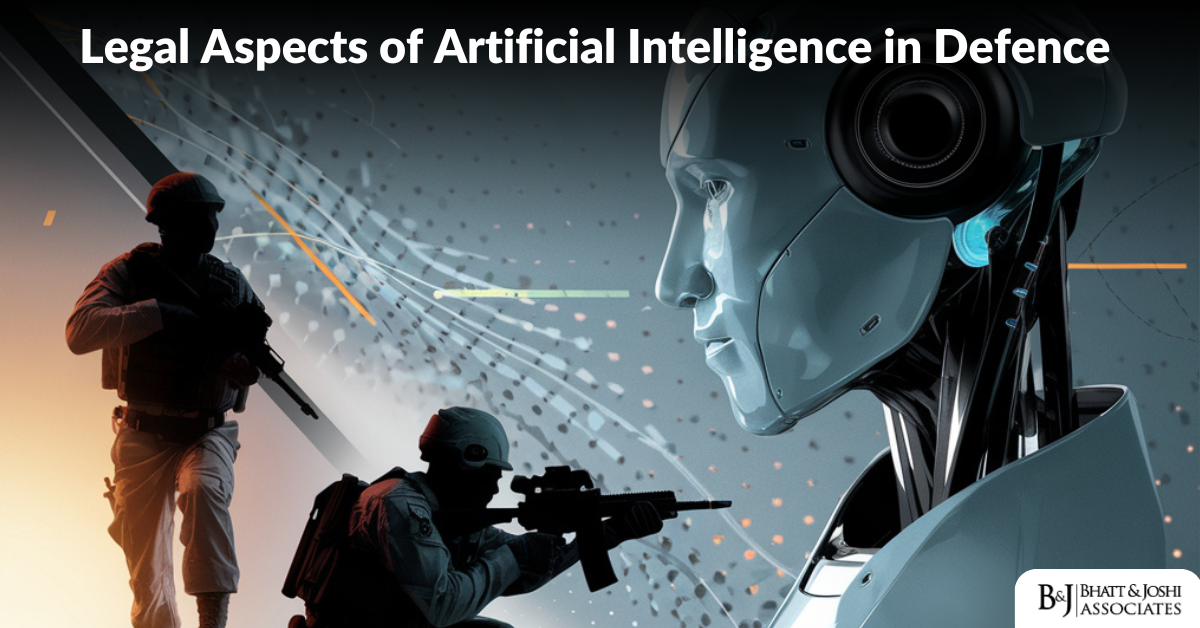Introduction
Artificial Intelligence (AI) has emerged as a transformative technology, reshaping industries and redefining national security paradigms. In the realm of defence, AI offers unprecedented opportunities to enhance operational efficiency, automate complex processes, and strengthen national security frameworks. However, these advancements also pose unique legal and ethical challenges. The integration of AI in defence raises questions about accountability, compliance with international humanitarian law, and the balance between technological innovation and human oversight. This article explores the legal aspects of Artificial Intelligence in defence, including its regulation, relevant laws, landmark judgments, and the broader implications of its deployment.
The Role of Artificial Intelligence in Defence
AI in defence encompasses a broad spectrum of applications, including autonomous weapons systems (AWS), surveillance, logistics, and cybersecurity. Autonomous drones, robotic soldiers, and AI-powered decision-making systems are no longer confined to science fiction. They are real tools with profound implications for modern warfare. AI enables more precise targeting, minimizes collateral damage, and enhances situational awareness on the battlefield. It also provides critical support in areas such as predictive maintenance of military equipment and real-time data analysis.
Despite these benefits, the deployment of AI in defence introduces risks of misuse, bias, and unintended consequences. Autonomous weapons, for instance, operate without direct human control, raising ethical concerns about decision-making in life-and-death situations. There is also the potential for adversaries to exploit AI vulnerabilities, such as hacking into systems or manipulating algorithms to disrupt operations. These risks necessitate a robust legal and regulatory framework to govern the use of AI in defence.
International Regulations Governing Artificial Intelligence in Defence
The regulation of Artificial Intelligence in defence is primarily governed by international law, including the principles of jus ad bellum (governing the use of force) and jus in bello (governing conduct during war). These principles provide the foundation for evaluating the legality of AI-driven defence systems.
The Geneva Conventions establish rules for humanitarian conduct in warfare, including the principle of distinction, which requires distinguishing between combatants and civilians, and proportionality, which mandates avoiding excessive harm to civilians. Autonomous weapons must comply with these principles to ensure that their use aligns with international humanitarian law. The requirement for human oversight in critical functions is a key element in maintaining compliance with these norms.
The United Nations Charter plays a pivotal role in regulating the use of AI in defence. Article 2(4) of the Charter prohibits the threat or use of force against the territorial integrity or political independence of any state. AI-driven defence systems must adhere to these provisions to prevent escalations and violations of sovereignty. Furthermore, the principles of necessity and proportionality are critical in determining the legality of using AI in military operations.
The Convention on Certain Conventional Weapons (CCW) is another crucial framework for regulating AI in defence. The CCW aims to restrict or ban specific categories of weapons that cause unnecessary suffering or have indiscriminate effects. Discussions under the CCW framework regarding the regulation of lethal autonomous weapons systems (LAWS) have highlighted the need for clear guidelines to prevent the misuse of AI technologies. While some nations advocate for a complete ban on LAWS, others emphasize the importance of responsible use and human oversight.
Customary international law also plays a vital role in addressing gaps in treaties. The Martens Clause, for instance, emphasizes adherence to the principles of humanity and public conscience, which are particularly relevant in the context of AI in defence. These unwritten norms provide a moral and legal compass for evaluating the deployment of AI technologies in warfare.
National Regulations and Policies
Countries across the globe have adopted varied approaches to regulating AI in defence. In the United States, the Department of Defense’s (DoD) AI Strategy emphasizes the ethical and accountable use of AI. The establishment of the Joint Artificial Intelligence Center (JAIC) reflects the DoD’s commitment to integrating AI into defence operations while adhering to ethical guidelines. The JAIC provides a centralized platform for coordinating AI initiatives, ensuring compliance with legal and ethical standards.
The European Union has proposed a regulatory framework that emphasizes trustworthiness, transparency, and accountability in AI applications. The European Commission’s Ethics Guidelines for Trustworthy AI serve as a foundation for member states to align their defence policies with human rights and ethical principles. These guidelines highlight the importance of human oversight, data privacy, and the prevention of bias in AI systems.
In India, the Defence Research and Development Organisation (DRDO) spearheads AI-driven initiatives for national security. While India has made significant progress in developing AI technologies, it lacks a comprehensive regulatory framework for AI in defence. Existing laws, such as the Information Technology Act and data protection regulations, provide a limited foundation for addressing the legal challenges posed by AI in military applications. There is a pressing need for dedicated legislation to govern AI in defence, ensuring accountability, transparency, and compliance with international norms.
Legal and Ethical Challenges of Artificial Intelligence Integration in Defence
The integration of AI in defence presents several legal challenges and ethical dilemmas. One of the most significant challenges is determining accountability and responsibility. If an AI-powered system malfunctions or causes unintended harm, it is unclear who should be held liable—the developer, operator, or manufacturer. This ambiguity complicates efforts to ensure accountability and justice in cases involving AI-related incidents.
Compliance with international humanitarian law is another critical concern. Autonomous systems must adhere to the principles of necessity, distinction, and proportionality, but ensuring that AI systems can interpret these principles in dynamic combat scenarios remains a contentious issue. The lack of transparency in AI decision-making processes further exacerbates these challenges, making it difficult to verify compliance with legal and ethical standards.
The issue of transparency and bias is particularly problematic in AI systems. Many AI algorithms function as “black boxes,” making it difficult to understand how decisions are made. This lack of transparency raises concerns about the potential for bias in target identification and other critical functions. Ensuring that AI systems are explainable and free from bias is essential to maintaining trust and accountability.
The use of AI in defence also increases vulnerabilities to cybersecurity threats. Adversaries can exploit weaknesses in AI systems to launch cyberattacks, disrupt operations, or manipulate data. Legal frameworks must address these risks by establishing robust cybersecurity standards and protocols.
Ethical concerns about the delegation of life-and-death decisions to machines are also central to the debate on AI in defence. Critics argue that machines lack the judgment and empathy required to make ethical decisions in complex, high-stakes environments. These concerns underscore the importance of maintaining human oversight in the deployment of AI technologies.
Case Laws and Judgments
Several legal cases and judgments have addressed issues related to AI and defence, setting important precedents for future developments. Israel’s use of autonomous drones for surveillance and targeted strikes has sparked international debate. While these systems demonstrate advanced capabilities, critics argue that they may violate international humanitarian law by failing to adequately distinguish between combatants and civilians. The lack of transparency in decision-making processes further complicates efforts to assess compliance with legal norms.
The Jadhav case (India vs. Pakistan) highlighted the importance of compliance with international law in matters of national security. Although not directly related to AI, the principles upheld in this case are relevant for AI-driven defence systems to ensure accountability and adherence to human rights. Similarly, the International Court of Justice’s judgment in the Oil Platforms case reaffirmed the need for proportionality in the use of force, a principle that is critical for the deployment of AI in defence.
United Nations discussions on lethal autonomous weapons systems have also played a significant role in shaping the legal and ethical landscape. While no binding judgment exists, these discussions emphasize the need for human control over critical functions, setting a de facto standard for future legal challenges. These precedents highlight the importance of balancing innovation with accountability in the use of AI in defence.
The Role of Soft Law and Ethics
In addition to binding regulations, soft law instruments such as guidelines, codes of conduct, and ethical principles play a vital role in shaping the use of AI in defence. The Asilomar AI Principles, for instance, emphasize the importance of aligning AI development with human values, transparency, and accountability. These principles provide a moral framework for evaluating the ethical implications of AI technologies.
The Tallinn Manual, though primarily focused on cyber warfare, offers valuable insights into how existing laws apply to emerging technologies, including AI in defence. These soft law instruments complement binding regulations by providing flexible and adaptive guidelines for addressing the challenges posed by AI.
The Way Forward: Balancing Innovation and Regulation
Achieving a balance between technological innovation and legal oversight is critical for the responsible integration of AI in defence. Policymakers must prioritize the development of robust regulatory frameworks to address the unique challenges posed by AI. Comprehensive laws should be adopted to ensure compliance with international standards, promote accountability, and safeguard human rights.
International cooperation is essential to establish global norms and prevent the misuse of AI in warfare. Collaborative efforts through the United Nations and other international bodies can facilitate the development of binding agreements and best practices. Nations must work together to address common challenges and promote the responsible use of AI in defence.
Fostering ethical AI development is another key priority. Developers and policymakers should prioritize fairness, accountability, and human oversight in the design and deployment of AI systems. Transparency and explainability should be central to AI development to ensure that decision-making processes are understandable and verifiable.
Governments must also invest in robust cybersecurity frameworks to protect AI-driven defence systems from adversarial attacks. Strengthening cybersecurity measures is critical to mitigating the risks posed by AI vulnerabilities and ensuring the resilience of defence systems.
Conclusion
The legal aspects of AI in defence are complex and multifaceted, requiring a nuanced approach that balances innovation with accountability. International and national laws must evolve to address the unique challenges posed by AI, ensuring that these technologies are used responsibly and ethically. By fostering collaboration, transparency, and compliance with humanitarian principles, the global community can harness the potential of AI in defence while safeguarding human rights and international peace.













